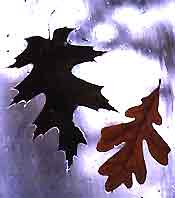
PLANT HORMONES
In plants such as trees there are five major types of chemical substances known as plant hormones. Three of these plant hormones promote plant growth and two inhibit it. The three growth promoters are auxins, gibberellins and cytokinins. The two growth inhibitors are ethylene and abscisic acid.
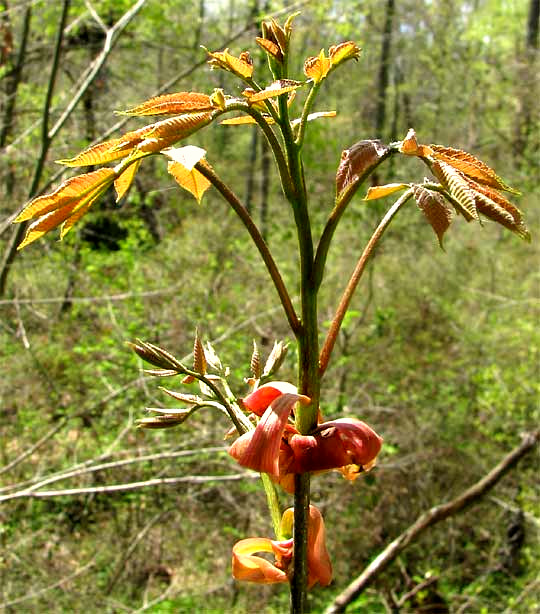
Hormone levels in leaf-dropping, or deciduous, trees are much influenced by both day length (photoperiod) and temperatures. As you might guess, spring's lengthening days and warming temperatures cause trees to produce lots of growth-promoting hormones -- especially as leaves unfurl, as with the Pignut Hickory, Carya glabra, at the left -- while fall's shortening days and cooling temperatures produce growth-inhibiting hormones.
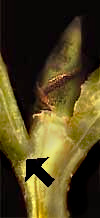
In the fall, growth-inhibiting hormones build up at the base of tree leaves (the petiole's base), causing the cells there to soften and weaken. That narrow zone is where eventually the leaf snaps off, is called the abscission layer. At the right, the black arrow points to the abscission layer at the petiole base of a Sweetgum tree, Liquidambar styraciflua. That picture was made in October just before the Sweetgum lost its leaves. By the way, the conical item at the top of the stem is the twig's terminal bud, from which next spring's new stem growth will arise.
OTHER REASONS LEAVES FALL

In many places where deciduous trees grow, if a drought occurs, trees may lose their leaves. This makes sense because leaves naturally lose water from their leaves by the process of transpiration. Transpiration is the unavoidable evaporation of water from cells inside the leaves (the spongy mesophyll), through minute "breathing holes" called stomata, mostly on the leaves' undersides.
The Pacific Madrone, Arbutus menziesii, at the left, reminds us that sometimes leaves naturally fall throughout the year, as they grow old and lose their ability to photosynthesize efficiently. This process may be sped up during droughts.
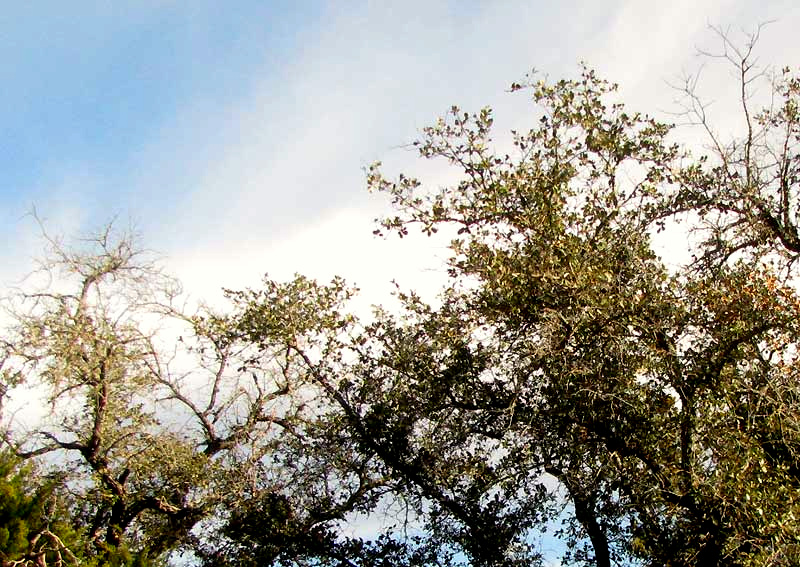
Diseases also can cause loss of leaves. At the right, leaves have fallen from dead branches -- and continue falling from dying branches -- of Texas Live Oaks, Quercus fusiformis. In Texas, vast oak populations are suffering "Oak Decline." Apparently the cause is that persistent drought has weakened the trees, enabling a fungus called Acremonium diospyri to clog up the trees' vascular systems.
Normally this fungus causes few problems, but when drought-stressed trees lose part of their immunity, the fungus becomes deadly. Similar slow, multi-cause "declines" are experienced with other species in many other regions, and are becoming more widespread with various kinds of stress caused by global warming.
TREES WITH EVERGREEN LEAVES
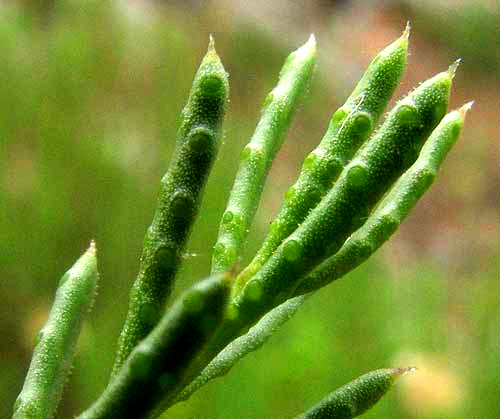
Remember that with conifers such as pines, spruce and fir, which bear needles instead of leaves with wide, flat blades, the needles technically are leaves. And evergreen conifers stay green with leaves through the year.
Also, at the left, note the much modified leaves of the semi-arid-living Damianita, Chrysactinia mexicana. Those evergreen leaves aren't needles, yet they're round in cross-section (less surface area for evaporating water), plus they're amply provided with circular glands producing a very strong taste and odor, preventing most animals from eating the plant.
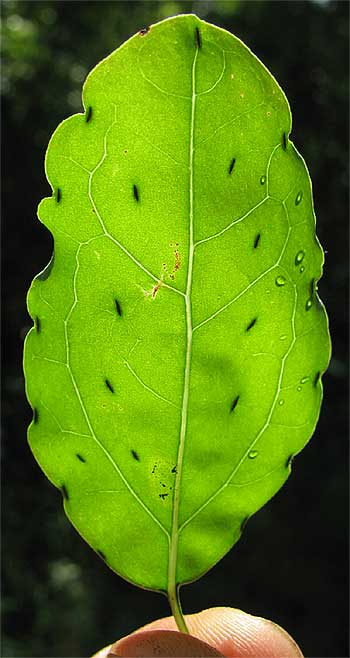
Those glands raise an interesting point. That is, when a plant bears the same leaves for a long time, insect populations and disease organisms have a home in and on the leaf, where they can multiply and make more trouble for the leaf year after year. Species with long-persisting leaves usually deal with this problem by resorting to chemical warfare. Make leaves bitter and/or toxic, and most critters will avoid them. At the left the tropical American herb Poreleaf, Porophyllum punctatum, displaying conspicuous glands filled with bitter, powerfully smelling essential oils. Various Poreleaf species are used traditionally not only as medicine but as insecticides.
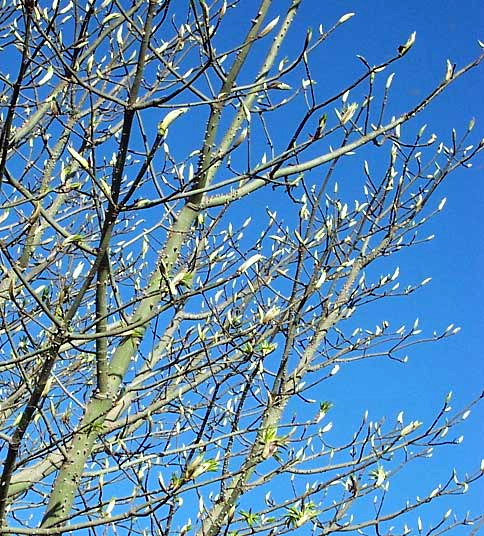
Many tropical trees do drop their leaves, despite living where there is no winter or dry season. That's the case with the tropical Ceiba tree, Ceiba pentandra, shown at the right in Mexico. At the end of a hot dry season when the tree became totally leafless for a few weeks, now the tree's terminal buds are issuing new stems and leaves. Interestingly, other tree species in the area kept their leaves during the whole season. Therefore, why do certain tropical trees drop their leaves when conditions aren't stressful enough to cause all species to shed their leaves?
For one thing, when deciduous trees drop their leaves, they're ridding themselves of leaf-eating insects, and those insects' eggs and larvae. A total leaf-drop interrupts the process of generation after generation of insects producing more and more of their leaf-chewing numbers. The same is true of disease organisms. Dropped leaves are older leaves that well may be infected. With new leaves, a disease must reinfect and start its life cycle all over again.
Shedding all leaves at once is one of many adaptive strategies that some species take advantage of, and others not. Those species who keep their leaves for over a year generally compensate for not using the strategy by protecting their leaves with powerful chemicals.